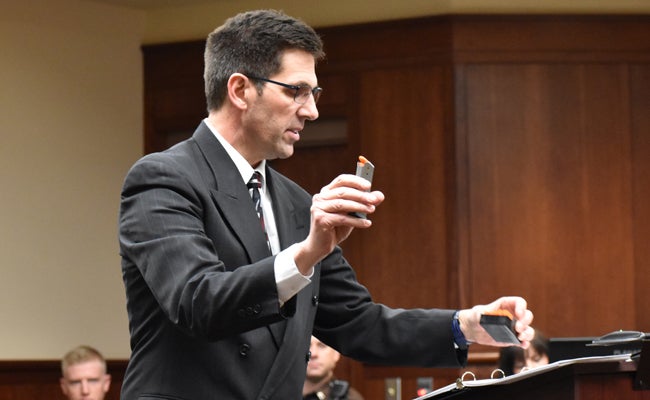Niles Township man facing murder charge awaits verdict
Published 9:51 pm Friday, February 15, 2019

- Assistant Prosecuting Attorney Jerry Vigansky gives his closing statement Friday and holds up a Kahr magazine that was submitted as evidence. (Leader photo/KELSEY HAMMON)
ST. JOSEPH — Assistant Prosecuting Attorney Jerry Vigansky used his closing argument Friday to illustrate the pieces of testimony heard throughout John Benton Lewis’ murder trial as parts of a puzzle coming together to form a complete picture.
With each point he made, a puzzle piece appeared on a TV screen in front of the jury, connecting with another puzzle piece – at last giving way to a picture of John.
Still, many details about the evening of Aug. 13, 2017, when John’s wife, Carla Jean Lewis, was fatally shot remain a mystery. Starting Friday, the jury was tasked with deciding if there was enough evidence to convict John of first-degree premeditated murder and unlawfully manufacturing a controlled substance or if too many pieces from the puzzle were missing.
The night of Carla’s death, John has alleged that two men hid in his home waiting for the opportune time to harm them. While John and Carla were moving marijuana plants in his grow room, John said the men fired at them, robbed them and stole Carla’s car, a dark cherry-colored Mazda. He described one of the suspects as a 6-foot-2 African American male weighing 300 pounds.
Before they began closing statements, the defense called five more witnesses to the stand, including neighbors. One, Latha Smith, described John as a helpful and said he was always willing to lend a hand.
The defense had intended to call one additional witness to the stand to discuss the prevalence of TulAmmo. The witness was scheduled to fly in from out of state early next week, but testimony wrapped up earlier than anticipated and they could not reschedule the witness’ plane ticket. Weiner-Vatter called for a mistrial and said it would not give them the chance to present their full case. Presiding Judge Gordon Hosbein denied the motion.
Prosecution pieces together the puzzle
In his closing statement, Vigansky sought to paint a picture of John as a man whose major passions in life were the women he was sleeping with, his bright green truck painted with marijuana leaves and the Sevenleaves Compassion Club, where medical marijuana cardholders gathered to smoke.
“Sex, money and drugs are powerful motives for murder,” Vigansky said.
Vigansky said John’s means for getting those items would have been access to Carla’s life insurance policy from her employer, Bayer, which would have entitled him to a total of $334,580.04, Vigansky said.
“That’s what Carla was worth to the defendant,” Vigansky said. “That would take care of his ability to maintain his passion, Sevenleaves. That would give him the money to give out all the dope he wanted to all his friends and girlfriends.”
On Aug. 7 and 8, days before Carla’s death, Vigansky cited testimony from Detective Sgt. Cory Peek which showed that there were numerous web searches on a computer collected from John’s home for a silencer and a Kahr Arms gun. Further testimony by Detective Sgt. Russell Karsten said an analysis of the bullets showed that a Kahr 9-millimeter gun was among the potential firearms used at the scene of the crime.
“The same type the defendant was looking for online,” Vigansky said. “The same type of silencer he was looking for online.”
Justin Hicks turned over a bag of eight boxes of 9-millimeter TulAmmo, a Kahr magazine, a box of Independence ammo and seven loose bullets. Hicks testified that John had asked him to get for him from Sevenleaves.
“The exact same kind that was found at the scene, as casings and the bullet that was found in Carla’s car,” Vigansky said. “And they are unique. They are Russian, steel cases.”
Hicks never got the ammo to John but turned it over to police.
Carla’s blood was found outside the grow room, on the rec room floor in the basement, up the stairs and on a door to the garage. Vigansky said the 911 call could not have been placed from the basement, because there was no service.
“We do know that at this time the defendant was running to the basement because he got Carla’s blood all over,” Vigansky said. “The only person that could deposit that blood was the defendant. He had it on his arms.”
While John said he had been robbed, Vigansky said there were no signs of forced entry and that the scene was not indicative of a robbery.
“It did not appear anything had been taken,” Vigansky said.
Carla’s family began crying softly as Vigansky brought the courtroom back to the moment she died. Vigansky stepped inside the life-size replica used to illustrate the grow room to the jury.
“[Carla] got hit five times,” Vigansky shouted. “Why didn’t the defendant get hit? Because he killed her. That’s why. He pulled that trigger.”
Vigansky acknowledged that aspects of the events that transpired on Aug. 13 remain a mystery.
“Is the whole case solved? No,” he said. “Did he get help? Probably.”
Using what they did know, he asked the jury to find John guilty.
Defense suggests reasonable doubt
Assistant Public Defender Jolene Weiner-Vatter said John had been accused of the crime only shortly after police arrived on scene Aug. 13.
“It’s easy to build your case backward when you have your mind already made up,” she said.
Weiner-Vatter said the time frame and forensic evidence does not support the theory that John drove Carla’s car himself. She also cited no proof of a transaction purchase for a gun.
She rebutted Vigansky’s statement that there had not been a robbery. She said Carla’s car, items from her purse and items from a safe had been taken.
She said John called 911 eight times to get through to a dispatcher. He was found near Carla when police arrived.
“Do criminals stick around after they shoot up a house?” Weiner-Vatter said.
Weiner-Vatter described how Carla’s car had been found roughly 10 miles away abandoned in a cornfield. She asaid testimony had indicated that the positioning of the driver seat was not large enough for a man of John’s size.
“Remember there was no blood found in that Mazda,” Weiner-Vatter said. “John had blood on his arms and shoes.”
An unidentified man was testified to have been spotted walking down the road around the time Carla’s car would have been hidden.
Carla and John’s relationship was not perfect, Weiner-Vatter said.
“Yes, he was unfaithful,” she said. “Yes, he was a hound, a dog. But adultery does not equal murder. He never talked about a future with those women.”
She asked the jury not to convict John and reminded them that the prosecution had to prove her client’s guilt beyond a reasonable doubt.
“No, beyond a reasonable doubt is not highly likely,” she said. “It’s not woulda, coulda, shoulda.”
The jury deliberated for approximately two hours on Friday afternoon. They will continue their deliberations Tuesday morning.






